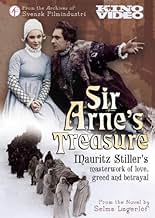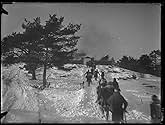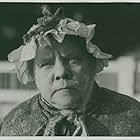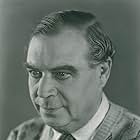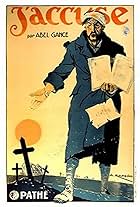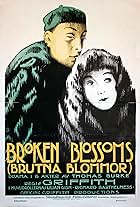VALUTAZIONE IMDb
7,1/10
1596
LA TUA VALUTAZIONE
Aggiungi una trama nella tua linguaIn 16th century Sweden, the lives of three Scottish mercenaries and a vicar's family intersect after a crime forever alters a small coastal town. As the three try to escape, they find themse... Leggi tuttoIn 16th century Sweden, the lives of three Scottish mercenaries and a vicar's family intersect after a crime forever alters a small coastal town. As the three try to escape, they find themselves trapped when all ships are frozen in ice.In 16th century Sweden, the lives of three Scottish mercenaries and a vicar's family intersect after a crime forever alters a small coastal town. As the three try to escape, they find themselves trapped when all ships are frozen in ice.
Josua Bengtson
- Jailer
- (non citato nei titoli originali)
Georg Blomstedt
- Inn-Keeper
- (non citato nei titoli originali)
Albin Erlandzon
- Sailor
- (non citato nei titoli originali)
Yngve Nyqvist
- Coal Worker
- (non citato nei titoli originali)
Artur Rolén
- Sailor
- (non citato nei titoli originali)
Trama
Lo sapevi?
- QuizThe screenplay by Mauritz Stiller and Gustaf Molander differs from the novel in that it tells the story in a more strictly chronological order, and incorporates some details which were introduced in the German play.
- ConnessioniFeatured in Historia del cine: Epoca muda (1983)
Recensione in evidenza
One is given to understand that painstaking efforts were undertaken to restore the film based on multiple surviving prints, and that endeavor paid off handsomely. If you can find just such a restoration to enjoy, then you will be greeted with 'Sir Arne's treasure' in all its silent splendor. It's not just that it's well made, and arguably just about as strong in its craftsmanship as any title to follow for years to come, even after the advent of talkies. There's also a wonderful finesse and subtlety to many aspects that well exceeds what one might suppose of early cinema. This applies to the terrific cinematography of Julius Jaenzon, as sharp and smart as he has illustrated elsewhere (such as with Victor Sjöström's 'A man there was' or 'The outlaw and his wife'), and possibly one of the chief highlights of this picture as it proves to be surprisingly dynamic and frankly rather advanced for 1919. The film editing is no less keen, and filmmaker Mauritz Stiller demonstrates firm command of the medium in orchestrating shots and scenes, a task made easier by a fine cast who all demonstrate commendable skill; of everyone, Mary Johnson stands out with an especially adept performance as Elsalill. Why, if film awards existed so early in the medium's history I'm quite sure Johnson and Jaenzon both would be surefire winners for their contributions here.
'Sir Arne's treasure' is certainly well-made in other regards, too. The filming locations are lovely, and more than this, the production design is outstanding. Still more admirable might be the costume design - no matter where one casts their gaze at any given point, the visual presentation is dazzlingly rich with detail. True, one might assume this of the silent era, where visuals were all important, but not all are equal across the board, and this surely counts among the greatest exemplars. Even the tinting applied to the film stock to indicate interior, exterior, or extreme conditions at the climax shows a splendid attentiveness that not all contemporary titles could claim. And overall, the adapted screenplay penned between Stiller and Gustaf Molander is fantastic, serving up a tragic but compelling narrative, and even more robust scene writing by which the tableau is assembled piece by piece. I don't think it's unfair to say that some scenes are sturdier as written than others, but by and large the result is so excellent that the feature becomes a classic of Swedish cinema, well worth remembering and exploring, and unreservedly deserving of such tremendous restoration.
It's not all good news. There's an awkward precision to how some moments are executed that butts against suspension of disbelief, even in matters as small as the exact timing of when characters happen to overhear another conversation. While I understand that 'Sir Arne's treasure' was adapted from a novel of some years prior, I wonder if the feature isn't a little too overfull of intertitles generally, and specifically those that relate exposition; had some reduced their verbiage, or been cut outright, the film may have had better narrative flow. To that point, I think the title is also bad at conveying the passage of time, and in some cases the plot progresses with a choppy Just So sensibility, declining connective threads, that further chips away at suspension of disbelief. There are aspects of the tale that one can only take at face value, as thinking too hard about the proceedings as they present raises meddling questions, and this is not even taking into account the light supernatural elements (that I gather are heavier in the source material). I can appreciate that some modern viewers have a hard time abiding silent movies - I would have said as much about myself at one time - and for as well made as it broadly is, I don't think this is a production that would change anyone's mind. Sadly, I'm also forced to ponder the reality of how some moments were captured, above all a scene with a horse that looks a lot to me like abject animal cruelty; I hope I'm mistaken.
Still, though the picture may fall short of perfect, ultimately its faults aren't so severe a detraction as to substantially diminish its value. I wish the narrative as we see it boasted greater flow, clarity, and connectivity, yet nonetheless it's complete, cohesive, and more solid than not. And when one then takes into account how fabulously strong 'Sir Arne's treasure' is in other regards, I ponder if I'm not being too harsh in the first place. Much more than not this is marvelous, a movie that anyone enamored of older cinema should make a point of watching at some point. If it isn't absolutely beyond critique, well, what is? I don't know that I'd say it's entirely an essential must-see, but it's well worth checking out if one has the opportunity, and its place in the annals of cultural history is very much earned.
'Sir Arne's treasure' is certainly well-made in other regards, too. The filming locations are lovely, and more than this, the production design is outstanding. Still more admirable might be the costume design - no matter where one casts their gaze at any given point, the visual presentation is dazzlingly rich with detail. True, one might assume this of the silent era, where visuals were all important, but not all are equal across the board, and this surely counts among the greatest exemplars. Even the tinting applied to the film stock to indicate interior, exterior, or extreme conditions at the climax shows a splendid attentiveness that not all contemporary titles could claim. And overall, the adapted screenplay penned between Stiller and Gustaf Molander is fantastic, serving up a tragic but compelling narrative, and even more robust scene writing by which the tableau is assembled piece by piece. I don't think it's unfair to say that some scenes are sturdier as written than others, but by and large the result is so excellent that the feature becomes a classic of Swedish cinema, well worth remembering and exploring, and unreservedly deserving of such tremendous restoration.
It's not all good news. There's an awkward precision to how some moments are executed that butts against suspension of disbelief, even in matters as small as the exact timing of when characters happen to overhear another conversation. While I understand that 'Sir Arne's treasure' was adapted from a novel of some years prior, I wonder if the feature isn't a little too overfull of intertitles generally, and specifically those that relate exposition; had some reduced their verbiage, or been cut outright, the film may have had better narrative flow. To that point, I think the title is also bad at conveying the passage of time, and in some cases the plot progresses with a choppy Just So sensibility, declining connective threads, that further chips away at suspension of disbelief. There are aspects of the tale that one can only take at face value, as thinking too hard about the proceedings as they present raises meddling questions, and this is not even taking into account the light supernatural elements (that I gather are heavier in the source material). I can appreciate that some modern viewers have a hard time abiding silent movies - I would have said as much about myself at one time - and for as well made as it broadly is, I don't think this is a production that would change anyone's mind. Sadly, I'm also forced to ponder the reality of how some moments were captured, above all a scene with a horse that looks a lot to me like abject animal cruelty; I hope I'm mistaken.
Still, though the picture may fall short of perfect, ultimately its faults aren't so severe a detraction as to substantially diminish its value. I wish the narrative as we see it boasted greater flow, clarity, and connectivity, yet nonetheless it's complete, cohesive, and more solid than not. And when one then takes into account how fabulously strong 'Sir Arne's treasure' is in other regards, I ponder if I'm not being too harsh in the first place. Much more than not this is marvelous, a movie that anyone enamored of older cinema should make a point of watching at some point. If it isn't absolutely beyond critique, well, what is? I don't know that I'd say it's entirely an essential must-see, but it's well worth checking out if one has the opportunity, and its place in the annals of cultural history is very much earned.
- I_Ailurophile
- 16 feb 2023
- Permalink
I più visti
Accedi per valutare e creare un elenco di titoli salvati per ottenere consigli personalizzati
Dettagli
- Tempo di esecuzione2 ore 2 minuti
- Mix di suoni
- Proporzioni
- 1.33 : 1
Contribuisci a questa pagina
Suggerisci una modifica o aggiungi i contenuti mancanti

Divario superiore
By what name was Il tesoro di Arne (1919) officially released in Canada in English?
Rispondi
